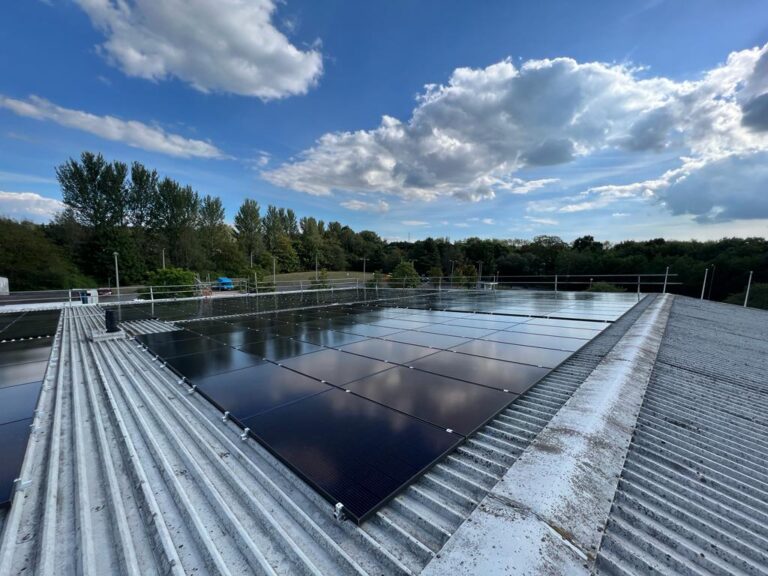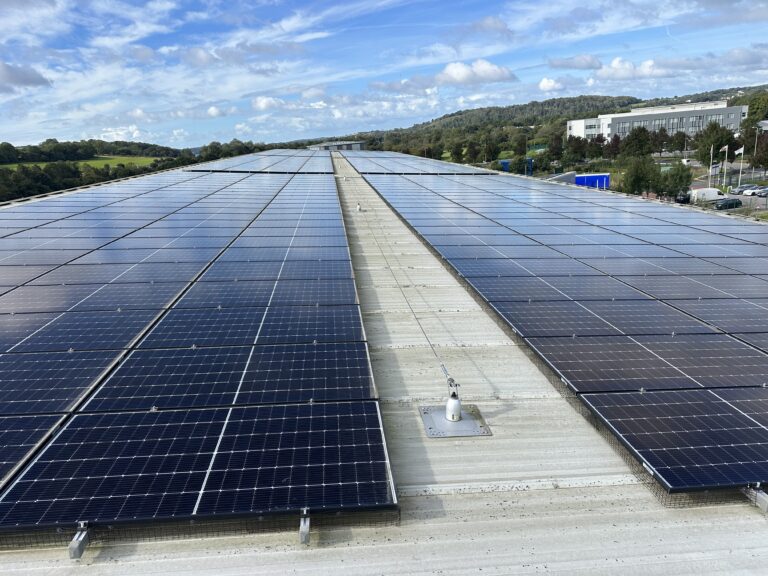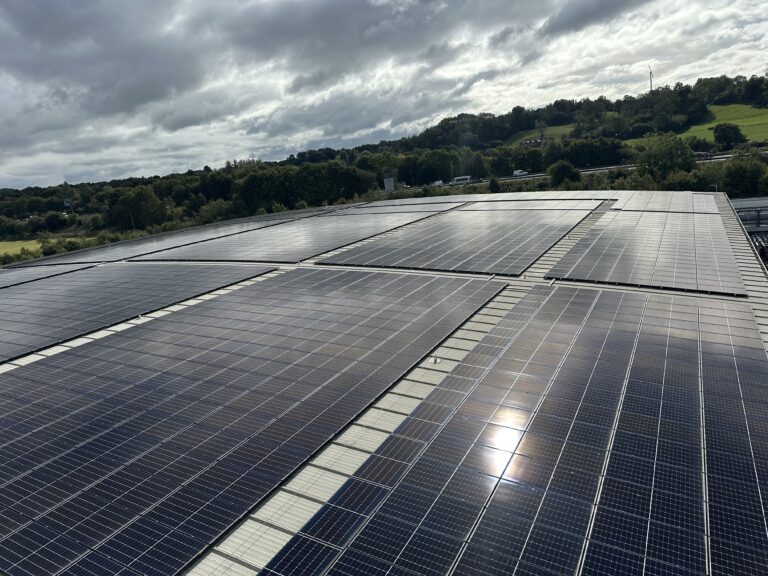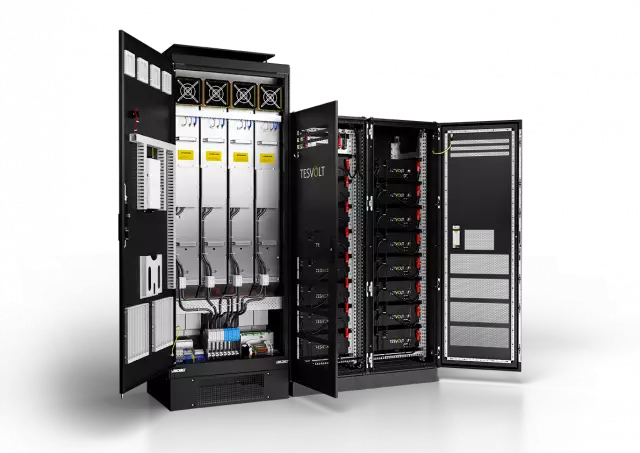Solar Panel Efficiency, Output, Cost, and Future Prospects
Evolution of Commercial Solar Panel Efficiency
The efficiency of commercial solar PV systems has improved dramatically over the years. Early solar panels operated at just 5-10% efficiency, but modern advancements have pushed efficiencies to 20-25%. This progress is driven by innovations such as monocrystalline silicon, PERC (Passivated Emitter and Rear Cell) technology, bifacial panels, and multi-busbar designs, which enhance energy yield and performance.
These technological improvements allow businesses to generate significantly more electricity from the same roof space, maximising energy output while reducing costs. Higher efficiency also makes solar power viable for commercial properties with limited installation areas, ensuring a faster return on investment. As solar technology evolves, commercial installations become increasingly attractive for companies seeking sustainability and long-term energy savings.

Benefits of Increased Solar Panel Efficiency
Improved solar panel efficiency means that businesses can install fewer panels while generating the same or more electricity, leading to:
Lower maintenance needs.
Reduced installation costs.
Higher return on investment (ROI).
Enhanced environmental benefits by reducing carbon footprints.
Most Efficient Solar Panels for Commercial Installations
When selecting solar panels for commercial installations, efficiency is a key factor in maximizing energy output and ROI. The market offers a range of options, from high-efficiency monocrystalline panels to innovative, flexible solutions like shingled and lightweight glass panels. Understanding the efficiency levels and unique benefits of each type can help you choose the best solution for your specific needs, ensuring long-term performance, cost savings, and environmental sustainability. Here’s a breakdown of the most efficient solar panel options available.
1. Monocrystalline Silicon (Mono-Si):
Offering the highest efficiency (18-22%), Mono-Si panels are ideal for commercial installations requiring maximum output and long-term performance.
2. Framed Shingled Panels:
These innovative panels deliver up to 23% efficiency, with enhanced shade tolerance, durability, and hotspot resistance. They are lead- and fluorine-free, making them a sustainable choice for structural integration.
3. Lightweight Glass PV Panels:
With up to 21.6% efficiency, these panels feature ultra-thin silicon wafers and a busbar-free design, improving performance even in low light. They require no mounting frame and are flexible for easy installation.
4. Polycrystalline Silicon (Poly-Si):
Offering 15-18% efficiency, Poly-Si panels are more cost-effective but slightly less efficient than Mono-Si, making them a good choice for projects with budget constraints.
5. Semi-Transparent BIPV Glass:
Combining aesthetics and functionality, this option provides 20% efficiency with 10% light transmission, making it suitable for projects requiring both solar energy generation and design integration.
6. Flexible CIGS Panels:
Lightweight and flexible, CIGS, Copper Indium Gallium Selenide, panels deliver up to 20% efficiency and are perfect for BIPV applications, performing well even in low light conditions.
7. Amorphous Silicon Transparent Panels:
Known for cost-effectiveness and seamless integration, these amber-tinted panels perform well in low light and offer good shading tolerance but are less efficient (around 12%).
Monocrystalline panels are the most efficient and durable choice for commercial installations, while framed shingled panels offer the best efficiency (up to 23%) in innovative designs. Lightweight, flexible panels are a great option for low-light performance and ease of installation, while Poly-Si panels provide a cost-effective alternative with a slightly lower efficiency.

Innovations in Solar Panel Materials
Recent advancements in solar technology are driving innovation in efficiency and versatility. Perovskite solar cells are emerging as a game-changer, offering the potential for efficiencies beyond 30% while reducing manufacturing costs. Tandem solar cells, which combine perovskite with silicon, enhance performance by capturing a broader spectrum of sunlight, significantly improving energy conversion rates. Meanwhile, transparent solar panels are being developed for urban applications, allowing windows and building facades to generate electricity without compromising aesthetics. These breakthroughs are shaping the future of solar energy, making it more efficient, cost-effective, and adaptable to diverse environments.
Perovskite Solar Cells
Offer potential efficiencies exceeding 30% while reducing production costs compared to conventional silicon-based cells.
Utilize perovskite materials, known for their exceptional light absorption properties.
Lab-scale prototypes have already surpassed 26% efficiency.
Despite rapid efficiency gains, large-scale manufacturing faces challenges related to stability and long-term durability.
Perovskite-silicon tandem designs have reached nearly 34% efficiency.
Tandem Solar Cells
The layered structure allows for better utilization of different light wavelengths, significantly improving efficiency.
Combine multiple materials, such as perovskite and silicon, to optimize energy capture.
Oxford PV has reported a record-breaking 28.6% efficiency for a commercial-sized tandem cell.
Research continues to enhance both the performance and lifespan of these advanced cells.
Transparent Solar Panels
Enable electricity generation from building surfaces, ideal for high-density urban areas.
Designed for seamless integration into windows, facades, and other urban structures.
Perovskite materials are particularly promising due to their flexibility and ability to be manufactured in thin, transparent layers.
These innovations are paving the way for more efficient and adaptable solar solutions, expanding possibilities for renewable energy integration across industries.

Commercial Solar Panel Sizes and Wattage
Commercial solar panel output, measured in watts (W), is influenced by factors such as efficiency, size, and technology. Most commercial photovoltaic (PV) panels range between 400W and 650W, with advanced high-efficiency models exceeding 600W for maximised energy generation.
Commercial solar panels are generally larger than residential panels, with typical dimensions of approximately 2 metres by 1 metre. Their increased size and wattage allow businesses to generate more electricity per panel, making them a cost-effective solution for large-scale energy production.
Higher wattage panels enhance energy output, making them particularly beneficial for businesses with limited roof space. By optimising power generation per square foot, these panels help improve return on investment while reducing dependence on grid electricity.
How much electricity do solar panels generate
The amount of electricity a solar panel generates depends on its wattage, size, and location. In the UK, where sunlight levels average around 4 peak sun hours per day, the expected daily energy production for a commercial panel can be estimated as:
Solar Panel Wattage (W) × Peak Sun Hours (h) = Daily Energy Output (Wh)
✅ For example, a 400W panel in the UK would generate: 400W × 4h = 1,600Wh (1.6 kWh) per day
✅ For a system with 100 panels (400W each): 100 × 1.6 kWh = 160 kWh per day
This energy output reduces reliance on the National Grid, lowering electricity costs for businesses.
Further Enhance Solar Energy Production with BESS
Commercial battery energy storage solutions, BESS, are key to maximising solar panel efficiency and optimising solar energy production. By storing excess solar energy generated during peak sunlight hours, businesses can use this power during off-peak times, increasing self-consumption and reducing reliance on the national grid.
These systems allow businesses to ensure their commercial solar PV panels operate at maximum efficiency. Instead of exporting excess energy back to the grid, stored solar power can be used when needed, resulting in increased energy savings and more sustainable operations.
By integrating battery storage, businesses can better manage their electrical consumption, reduce energy costs, and improve the overall performance of their solar energy systems.

What is the Solar Panel Output Per Square Foot?
Commercial solar panel output is measured in watts (W) and varies based on efficiency, size, and technology.
Standard photovoltaic (PV) panels typically range from 400W to 650W, while advanced high-efficiency models can exceed 600W.
A high-efficiency panel (23%) produces around 15-20 watts per square foot. Given the UK’s solar conditions, this equates to approximately 60-80Wh per square foot per day.
Higher wattage panels generate more power in less space, making them ideal for businesses aiming to reduce energy costs and maximise return on investment.
How Much Power Can a Solar Panel Generate?
Commercial solar power generation varies depending on system size, panel efficiency, and local sunlight conditions. Installations can range from smaller 10kW systems for businesses with moderate energy needs to large-scale 1MW+ solar farms designed for high-demand operations.
A 100kW solar system, comprising approximately 250x400W panels, typically produces between 85,000 and 100,000 kWh annually in the UK. This level of output helps businesses offset a substantial portion of their electricity costs while improving energy security.
The power output of an individual solar panel depends on its wattage and exposure to sunlight. In UK conditions, a 500W panel can generate around 2 kWh per day, equating to approximately 730 kWh per year.
For businesses investing in a larger 250 kW system with 500x500W panels, the estimated annual energy generation would be around 182,500 kWh. This substantial output not only reduces energy bills but also enhances sustainability credentials, supporting long-term cost savings and environmental responsibility.
Commercial Solar Panel Cost Per Square Foot
The cost of commercial solar panels varies based on panel type, efficiency, and installation complexity. In the UK, solar panel system costs range from £650-£950 per kW. For a typical 50kW system, costs range from £32,500-£47,500.
When translated into cost per square foot, commercial solar panels cost approximately £4-£7 per square foot, depending on the panel efficiency and installation specifics.

Grants for Solar Panels
Businesses can access grants for solar panels to help offset the cost of commercial solar panel installation. Several government incentives and tax relief schemes are available to encourage investment in commercial solar panels UK, including:
Enhanced Capital Allowance (ECA):
Provides tax relief for businesses investing in energy-efficient equipment, including solar PV systems.
The Smart Export Guarantee (SEG):
Allows businesses to sell excess electricity back to the grid, creating additional revenue streams.
Local and Regional Renewable Energy Grants:
Various regional programs offer financial support for commercial solar projects.
Industrial Energy Transformation Fund (IETF):
Supports industrial sites with high energy usage as they transition toward a low-carbon future by improving energy efficiency.
Salix Finance:
A government-backed scheme offering interest-free loans for public sector businesses to invest in energy efficiency projects.
Public Sector Decarbonisation Scheme:
Provides funding for public buildings, including schools and hospitals, to install solar PV and transition to cleaner energy sources.
Annual Investment Allowance (AIA):
Allows businesses to claim up to £1 million annually for qualifying plant and machinery, including solar panels.
UK Shared Prosperity Fund (UKSPF):
Part of the UK government’s Levelling Up agenda, allocating £2.6 billion to support local renewable energy investments.
Clean Energy Transition Fund:
A £4 billion initiative dedicated to solar PV energy and hydrogen developments, positioning these technologies at the core of the UK’s future energy mix.
Future Prospects of Commercial Solar Panels
The future of commercial solar panels UK is promising, with innovations in efficiency, storage, and smart-grid integration driving adoption. Key trends include:
Energy Storage Integration:
Battery storage solutions are becoming more affordable, enabling businesses to store excess energy.
Improved Efficiency:
Next-generation PV panels, including perovskite and tandem solar cells, could exceed 30% efficiency.
Government Incentives:
Tax relief and energy buyback schemes make commercial solar panel installation a sound investment.
Bifacial & Transparent Solar Panels:
These capture sunlight from both sides, increasing energy yield and expanding installation possibilities.
Conclusion
Commercial solar panels offer businesses a reliable, cost-effective, and sustainable energy solution. Understanding efficiency, output, and costs helps companies make informed investment decisions. With continued advancements in commercial solar PV, businesses in the UK can expect even greater returns from commercial solar installations in the coming years.
